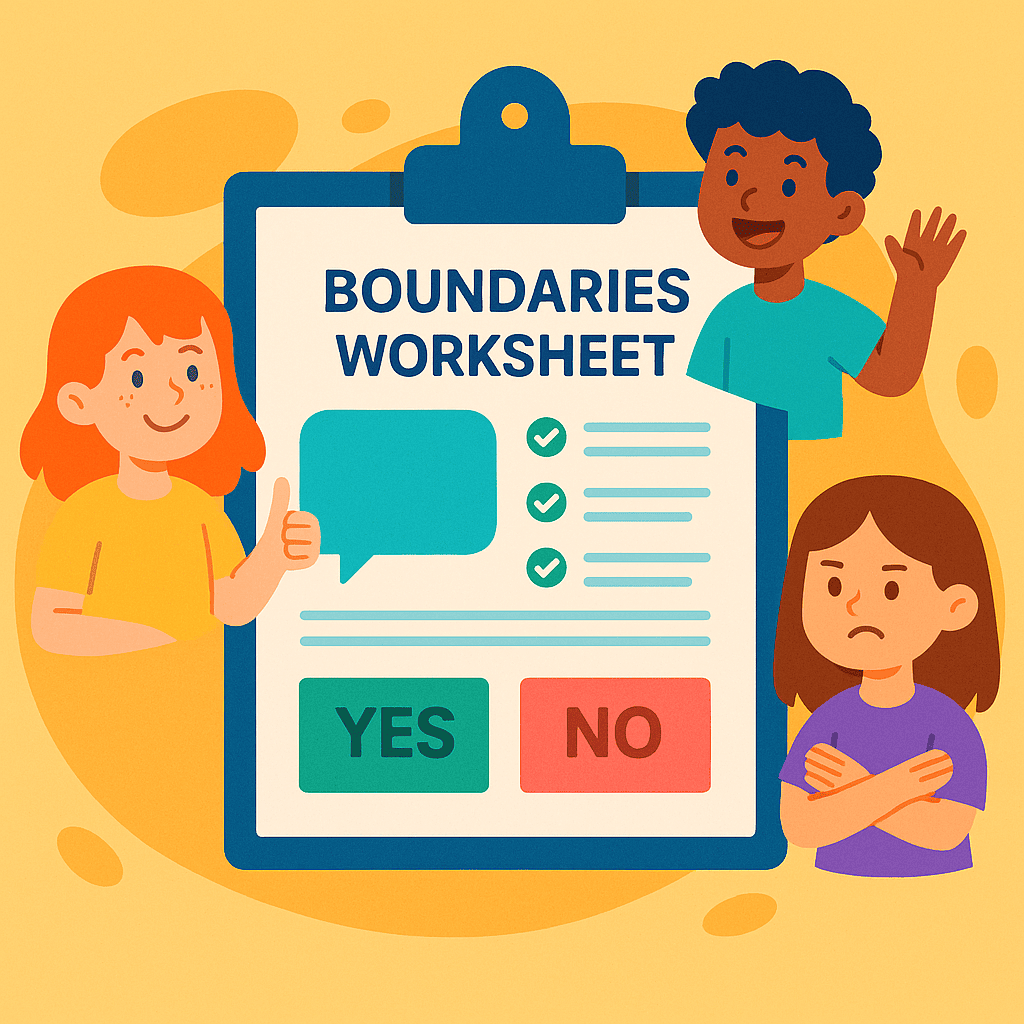Updated on: July 28, 2025
Introduction
Children benefit immensely from learning about personal limits—physical, emotional, social, and digital. Boundaries worksheets are visual and interactive tools that help young clients articulate their limits, practice assertiveness, and build self-awareness. When used within therapeutic settings, they strengthen emotional intelligence, communication, and healthy relationships.
This guide covers:
- Why boundaries matter for children’s development
- Types of boundaries every child should understand
- Therapeutic strategies using worksheets
- Integration into clinical workflow
- Chart ideas to illustrate progress and understanding
- Best practices, special considerations, and ethical guidance
Why Teach Boundaries Early?
Promotes Healthy Relationships
Boundaries worksheets help children understand their personal space and preferences—learning to say “no” when uncomfortable and asking for respectful interaction. This boosts safety and fosters mutual respect with peers and adults.
Builds Self-Esteem and Autonomy
Recognizing and communicating their own limits gives children a sense of ownership over their bodies and choices. It contributes to increased confidence and emotional clarity.
Fosters Emotional Awareness
Through boundary-building, children develop empathy, respect for others’ boundaries, and a stronger emotional vocabulary. This is essential for conflict resolution, self-regulation, and empathy.
Enhances Communication Skills
Practicing boundary setting encourages assertiveness in age-appropriate ways. Children learn to express preferences and needs clearly, reducing interpersonal friction.
These benefits have been documented as crucial during developmental years and reinforced through repeated therapeutic use.
Exploring Types of Boundaries
Understanding boundary categories helps children and caregivers contextualize interactions. Worksheets often break these down:
- Physical Boundaries: Who can touch, how, and when. Children learn consent and bodily autonomy.
- Emotional Boundaries: Comfort with emotional expression and listening to others’ needs.
- Social Boundaries: Choices in interactions, playtime, and peer connections.
- Time Boundaries: Recognizing when a break is needed or personal downtime is important.
- Material Boundaries: Respecting ownership of toys, snacks, and personal items.
- Intellectual Boundaries: Sharing thoughts and ideas while expecting respectful feedback.
- Digital Boundaries: Screen time limits, online consent, and privacy rules.
Exercise examples often include identifying and listing one’s comfort zones, role-playing boundary-setting statements, or dividing circles that represent different boundary zones.
Therapeutic Applications
Assessment and Psychoeducation
Worksheets can introduce the concept of boundaries to clients during intake or early sessions—helping them name discomforts, recognize safe spaces, and explore personal limits.
Family and Caregiver Involvement
Engage parents/caregivers by using worksheets in joint sessions. Support shared understanding of expectations and reinforce boundary messaging at home.
Emotion Regulation and Assertiveness Training
Children practicing phrases like “Please don’t touch me right now” or “I need quiet time” learn to express needs assertively and appropriately.
Homework and Reinforcement
Sending a worksheet home allows children to reflect on boundary violations or successes outside sessions, promoting self-monitoring and routine follow-up.
Chart Ideas to Enrich Your Blog
Pie Chart: Confidence in Setting Boundaries by Age Group
Illustrate what proportion of kids feel comfortable saying “no” by age (e.g. 5–6, 7–9, 10–12). Based on survey or anecdotal clinic data.
Bar Chart: Types of Boundaries Kids Find Most Challenging
Show percentages for physical, emotional, social, digital, intellectual boundaries.
Flowchart: How to Use a Boundaries Worksheet in Session
Session → Introduce concept → Complete worksheet → Role-play → Reflect → Assign homework
Table: Boundary Type vs. Example & Communication Script
| Boundary Type | Example Scenario | Kid-friendly Response |
|---|---|---|
| Physical | Being hugged unwantedly | “I don’t want a hug right now, thank you.” |
| Emotional | Someone yelling at me | “That makes me upset—stop yelling please.” |
| Social | Peer forces game choice | “I’d rather do something else instead.” |
| Time | Overstimulated at playtime | “I need a quiet break now.” |
Best Practices for Clinicians
- Use age-appropriate design: worksheets for younger kids can include faces or colors, older children need more verbal prompts.
- Normalize the concept: clarify that all boundaries are healthy, and feelings about boundaries evolve.
- Model healthy communication: therapists and caregivers should themselves model asking and respecting boundaries.
- Revisit periodically: boundary awareness and application grow over time; integrate worksheets into multiple sessions.
- Pair with coping tools: such as emotion labeling, breathing exercises, or assertive dialogues.
Case Scenarios
Case A: Five-Year-Old Overwhelmed by Physical Touch
Worksheets help the child identify uncomfortable touches and practice saying “Please stop” or indicating use of personal space.
Case B: Nine-Year-Old Struggling with Peer Social Pressure
The child learned to say no to being included in games they dislike using phrases that preserve friendship while honoring personal limits.
Case C: Teen Feeling Emotionally Inundated at Home
Works on emotional boundaries—learning to request alone time or calm spaces, and articulating when they feel emotionally drained.
Ethical Considerations & Limitations
- Respect cultural differences: boundary norms vary across cultures; tailor activities to fit family values.
- Consent and privacy: worksheets include sensitive reflections—use age-appropriate confidentiality explanations.
- Avoid forced disclosure: children shouldn’t be pushed to identify trauma via worksheets alone—keep sessions supportive and paced.
- Adapt for neurodiversity: visual supports, simplified language, or caretaker involvement can enhance engagement for children with autism or ADHD.
Summary & Key Takeaways
- Boundaries worksheets are powerful interventions that support emotional intelligence, self-advocacy, and respectful interactions.
- Teaching different types of boundaries (physical, emotional, social, digital) helps children internalize safe behavior.
- Worksheets can be used in individual, group, or family therapy, and as take-home reinforcement tools.
- Visual tools like charts and tables can illustrate progress and common areas of difficulty.
- Ethical use and developmental sensitivity maximize therapeutic impact.
Want to help kids build respectful assertiveness and boundary awareness in your practice?
Join DocScrib—your AI-powered assistant for creating child-friendly worksheets, session notes, and therapeutic planning that supports clear boundaries and emotional growth. Book your free demo
